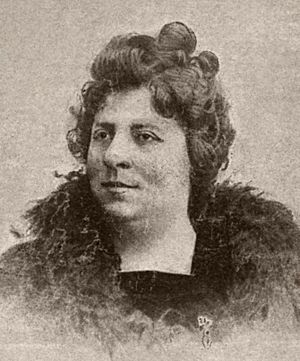Hedwige Chrétien facts for kids
Hedwige Chrétien (born July 15, 1859 – died 1944) was a talented French composer. She wrote many different kinds of music, from pieces for piano to big orchestral works and even operas.
Contents
Her Life and Music
Hedwige Chrétien was born in a town called Compiègne in France. She loved music from a young age and began studying at the famous Paris Conservatoire in 1874. This is a special school where people learn to become great musicians and composers.
Hedwige was a very bright student. In 1881, she won first prize for her skills in harmony, counterpoint, and fugue. These are all important parts of music composition. She also won top prizes for playing the piano and for her own musical compositions.
After finishing her studies, Hedwige Chrétien became a professor at the Paris Conservatoire in 1889. This was a big achievement! She was a very busy composer, creating about 150 different pieces of music during her life. Her works included:
- Music for the Piano
- Pieces for a full Orchestra
- Chamber music (for small groups of instruments)
- Songs for singers
- Two Ballets (music for dance)
- Two short Operas (musical plays)
Even though she wrote so much music, not a lot is known about her personal life. Today, one of the largest collections of her music in the United States is kept at the University of Michigan's Women Composers Collection.
What Kind of Music Did She Write?
Hedwige Chrétien wrote music for many different instruments and groups. Here are some examples of the types of music she composed:
Ballets
Ballets are stories told through dance, with music to guide the dancers.
- Ballet orientale
- La Valée des sphinx (The Valley of the Sphinxes)
Chamber Works
Chamber music is written for a small group of instruments, often played in a smaller room or "chamber."
- Berceuse (for violin)
- Grand solo (for trombone)
- Trio pour violon, violoncello and piano (a piece for violin, cello, and piano)
Choral Music
Choral music is written for a choir, which is a group of singers.
- L'Angelus
- Nos Soldats (Our Soldiers) – a dramatic scene for solo singers and choir with an orchestra.
Operas
Operas are plays where the story is told mostly through singing, with music and costumes.
- La Cinquantaine (The Fiftieth Anniversary) – a short opera for young girls.
- Menuet de l'Impératrice (The Empress's Minuet) – another short opera for young girls.
Orchestral Music
Orchestral music is written for a large group of instruments called an orchestra.
- Belle époque (Beautiful Era)
- Danse Rustique (Rustic Dance)
- L'Escarpolette (The Swing) – a waltz for orchestra.
Organ and Harmonium Music
She also wrote pieces for the Pipe organ or Harmonium, which are instruments often found in churches.
- Cinq pièces brèves (Five Short Pieces)
- Harmonies religieuses (Religious Harmonies)
Piano Music
Hedwige Chrétien wrote many pieces for the piano, both for one player and for two players at one piano (called "piano four hands").
- Ariel – a fantasy piece.
- Les Papillons (The Butterflies) – a salon waltz.
- Pour endormir Yvonne (To Put Yvonne to Sleep) – a lullaby.
- Tarentelle – for piano four hands.
- Sonatines (short sonatas):
- No.1: Pastorale
- No.2: Dès l'Aurore (At Dawn)
- No.3: Joyeuse Nouvelle (Joyful News)
Vocal Music
Most of her vocal pieces were songs for a singer with piano accompaniment. Some also included other instruments like the violin.
- Aubade
- Chanson des pêcheurs de lune (Song of the Moon Fishermen) – a duet for two voices.
- La Nuit (The Night) – for two voices, violin, and piano.
- Le Cor (The Horn)
- Pour nos soldats, prière (A Prayer for Our Soldiers) – she wrote both the words and music for this one.
Recordings
You can still listen to Hedwige Chrétien's music today! Some of her pieces have been recorded:
- Her Quintette (a piece for five instruments) was recorded on an album called Casino Belle Epoque.
- Her piece Vision was recorded in 1933 by Gaston Crunelle (playing the flute) and Lucien Petitjean (playing the piano).


